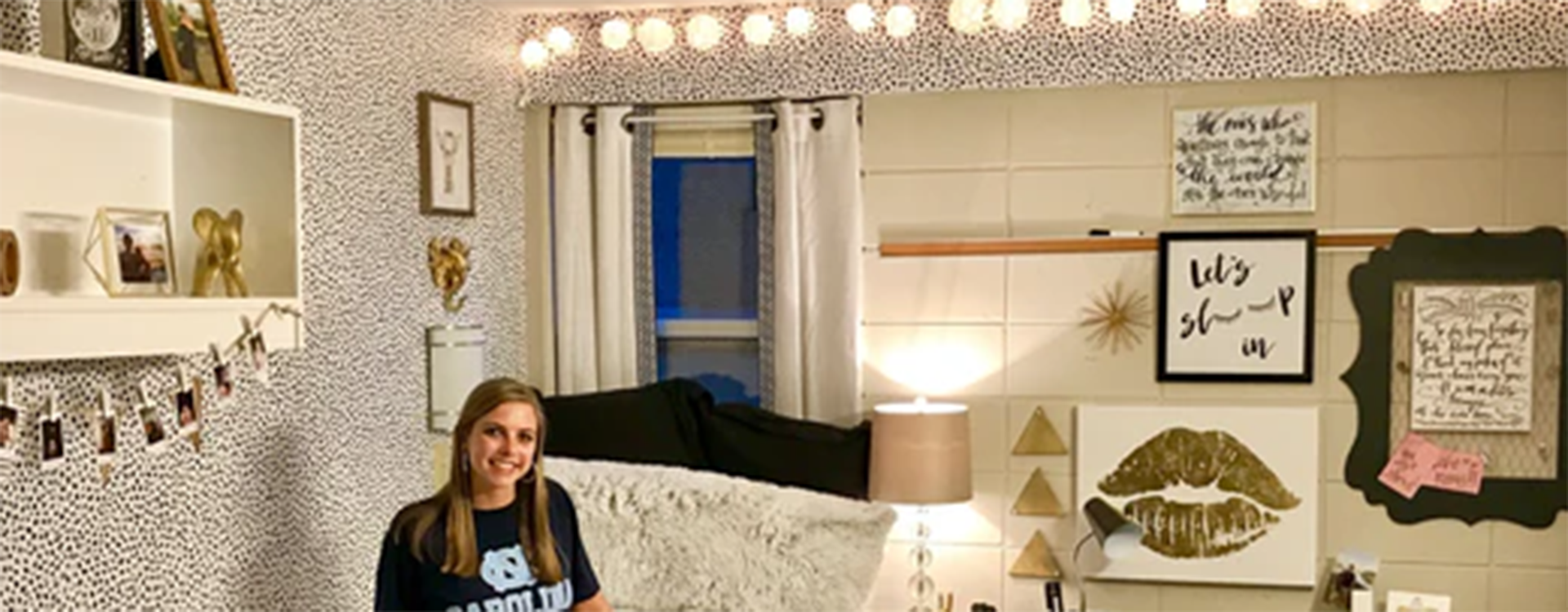As college students, we’re not just learning in the classroom—we’re also figuring out how to live more sustainably. Whether it’s reducing our carbon footprint or finding ways to be more eco-conscious in our daily lives, every small step counts. And yes, this includes how we decorate our dorm rooms! With a little creativity and some smart choices, we can make our living spaces not just stylish and comfortable, but also kind to the planet.
In this blog, we’ll dive into how you can incorporate eco-friendly practices into your dorm room decor, explore sustainable alternatives to traditional furnishings, and even see how Y2K-inspired decor can fit into a green dorm room.
How Can Students Incorporate Eco-Friendly Practices into Their Dorm Room Decor?

1. Choose Recycled and Upcycled Materials:
When it comes to eco-friendly decor, start by thinking about where your materials come from. Instead of buying new, consider using recycled or upcycled items to decorate your dorm room. For example, you can turn old wooden crates into stylish storage units by painting them or leaving them in their natural, rustic state. If you have an old ladder lying around, repurpose it as a unique shelving unit for books or plants. Glass jars from pasta sauce or pickles can be cleaned and used as plant holders, vases, or even for organizing small items like pens and pencils. If you’re crafty, you can upcycle an old t-shirt into a pillow cover or make a hanging planter from recycled fabric, adding a personal and eco-friendly touch to your space.
2. Go for Secondhand:
Thrift stores, garage sales, and online marketplaces are gold mines for finding unique and sustainable decor items. Not only are you saving money, but you’re also giving items a second life. For example, you might find a vintage lamp that just needs a new shade or a small table that can be sanded down and repainted to fit your style. Even furniture like desks, chairs, and shelves can often be found secondhand and customized with a bit of DIY effort. Whether it’s a quirky chair you can reupholster with fabric scraps or retro posters that give your room a nostalgic vibe, secondhand finds add character to your room while reducing waste. Plus, you get to brag about your awesome finds and the stories behind them!
3. Opt for Natural and Organic Materials:
When decorating your dorm, look for items made from natural and organic materials. For instance, choose bedding and curtains made from organic cotton or linen, which are better for the environment and often last longer than synthetic materials. You can find organic cotton throw blankets or linen pillowcases that not only feel luxurious but also reduce your exposure to harmful chemicals. A jute or bamboo rug is another great addition that’s both stylish and sustainable. These natural fibers are biodegradable and have a lower environmental impact compared to synthetic options. Not only do these materials look great, but they also help reduce the amount of synthetic fibers entering our ecosystems, making your dorm room both cozy and eco-friendly.
4. DIY with a Green Twist:
DIY projects are a great way to personalize your space, but they can also be an opportunity to go green. Use eco-friendly paint for your wall art—look for brands that offer low-VOC (volatile organic compounds) options, which are better for your health and the environment. If you’re making decor items, try using materials you already have or can easily source sustainably. For example, create decor using natural elements like pine cones, stones, or dried flowers. You can make a simple yet beautiful wall hanging using a branch and some twine, or create a zen-like atmosphere with a DIY rock garden. If you love candles, try making your own using soy wax and essential oils in recycled glass jars. The key is to use materials that are sustainable and minimize waste, so your DIY projects are both beautiful and eco-friendly.
What Are Some Sustainable Alternatives to Traditional Dorm Room Furnishings?
1. Recycled and Reclaimed Furniture:
Instead of buying new, consider furniture made from recycled or reclaimed materials. Many companies now offer products like desks, chairs, and shelving units made from reclaimed wood or recycled plastic. These pieces not only reduce the demand for new materials but also often have a cool, rustic look that adds character to your dorm room.
2. Multi-Functional Furniture:
Another great way to be sustainable is to choose multi-functional furniture. Items that serve more than one purpose reduce the need for multiple pieces, saving both space and resources. For example, a bed with built-in drawers eliminates the need for a separate dresser, or a fold-out desk can double as a nightstand. Look for pieces that are designed with sustainability in mind—those that use fewer materials and are built to last.
3. Bamboo and Cork Furnishings:
Bamboo and cork are two of the most sustainable materials out there. They’re fast-growing, renewable, and require less energy to produce than traditional wood or plastic. Consider adding a bamboo desk organizer, a cork bulletin board, or even a bamboo chair to your dorm room. These materials are not only eco-friendly but also add a natural, calming vibe to your space.
4. Sustainable Bedding:
Your bed is the centerpiece of your dorm room, so why not make it eco-friendly? Look for bedding made from organic cotton, hemp, or bamboo, all of which are more sustainable than conventional cotton. Organic bedding is not only better for the environment but also softer and more breathable, making your sleep more comfortable. Plus, you can find these materials in a range of colors and patterns to suit your style.
How Does Y2K Room Decor Neon Sign Fit into a Sustainable Dorm Room Environment?
1. Opt for Energy-Efficient LED Neon Signs:
Traditional neon signs use a lot of energy and aren’t the most eco-friendly option. But if you love the Y2K aesthetic, you can still incorporate it into your dorm room with energy-efficient LED neon signs. These signs use less power and have a longer lifespan, making them a more sustainable choice. Whether it’s a quirky phrase or a simple shape, an LED neon sign can add that nostalgic Y2K vibe without harming the planet.
2. Combine with Natural Decor:
Balance the boldness of a neon sign with other natural elements in your room. For example, place your neon sign above a bed with organic cotton bedding or next to a shelf of potted plants. This combination of modern and natural decor creates a harmonious look that’s both stylish and sustainable.
3. DIY Faux Neon Signs:
If you’re feeling creative, why not make your own faux neon sign using LED neon flex? This DIY project allows you to customize the design and reduce the environmental impact of traditional neon. Plus, it’s a fun way to personalize your space with a unique piece that reflects your style.
4. Reuse and Repurpose:
If you already have a neon sign from previous years, consider repurposing it instead of buying new decor. You can update the look by incorporating it into a new theme or combining it with other sustainable decor elements. Reusing what you already have is one of the most effective ways to reduce waste and promote sustainability in your dorm.

What Are Tips for Reducing Waste and Promoting Sustainability in Dorm Living?
1. Start with a Minimalist Approach:
One of the best ways to reduce waste is to avoid overbuying in the first place. Before you move into your dorm, make a list of essentials and stick to it. For example, instead of buying multiple sets of bedding, choose one or two high-quality, versatile options that you love and that will last the entire school year. Similarly, opt for a few multifunctional items, like a lamp that also serves as a charging station, rather than cluttering your room with several single-use gadgets. Embrace a minimalist approach by choosing fewer, high-quality items that you truly need and love. This not only reduces clutter but also means you’re less likely to throw things away at the end of the year.
2. Use Reusable Items:
Swap out single-use items for reusable alternatives. For example, bring a reusable water bottle, coffee cup, and shopping bags to campus. Instead of using disposable plastic cutlery, invest in a set of portable utensils that you can carry with you. For storing snacks or leftovers, use glass or stainless steel containers instead of single-use plastic bags or wraps. These small changes can significantly reduce your waste over time. Additionally, using a reusable cloth for cleaning instead of paper towels can help you cut down on waste and save money.
3. Recycle and Compost:
Set up a small recycling station in your dorm room to make it easy to sort recyclables like paper, plastic, and glass. For example, you could use a couple of labeled bins or even cardboard boxes to separate recyclables from trash. If your campus offers composting, participate by collecting food scraps and compostable items in a small, odor-sealed bin. Even if composting isn’t available on campus, you can start a mini-compost system with a small countertop compost bin and bring it to a local composting facility when full. Even in a small dorm room, it’s possible to make recycling and composting part of your daily routine, helping reduce your overall waste footprint.
4. Choose Eco-Friendly Cleaning Products:
When it’s time to clean your dorm room, opt for eco-friendly cleaning products. Many conventional cleaners contain harmful chemicals that can pollute the air and water. Instead, look for products that are biodegradable and free of harsh chemicals. For example, brands like Seventh Generation or Method offer green cleaning solutions that are effective and safe for the environment. Alternatively, you can make your own cleaners using simple ingredients like vinegar, baking soda, and lemon juice. Mix vinegar and water in a spray bottle for an all-purpose cleaner, or use baking soda as a natural abrasive for scrubbing tough spots. These choices are better for the environment and often just as effective as conventional cleaners.
5. Educate and Inspire Others:
Finally, one of the best ways to promote sustainability is by educating and inspiring your fellow students. Share your eco-friendly dorm room tips with friends—maybe start a group chat or social media page where you can swap ideas and resources. Participate in campus sustainability initiatives like clothing swaps, zero-waste events, or community clean-up days. Encourage others to make small changes in their own lives, like using reusable items or participating in recycling programs. You could even organize a DIY workshop to teach others how to create sustainable dorm decor. By creating a community that values sustainability, you can amplify your impact and help create a greener campus.
Conclusion
Living sustainably in a dorm room is all about making mindful choices. From choosing recycled and upcycled materials to incorporating energy-efficient LED neon signs, there are plenty of ways to decorate your space without harming the planet. By embracing a minimalist approach, using natural and organic materials, and opting for sustainable alternatives to traditional furnishings, you can create a dorm room that’s not only stylish but also eco-friendly. Remember, every small change counts, and together, we can make a big difference in promoting sustainability on campus. Happy decorating!





















